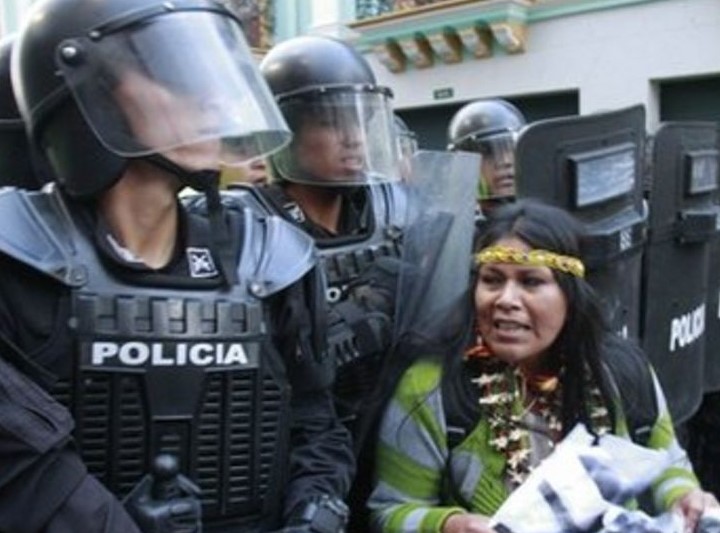Latin America, including Ecuador, remembers the ‘disappeared’ during the bloody reign of dictators
By Emily Ellison
From the 1950s through the 1980s, Latin America was notorious for its brutal dictators, particularly for the way they tortured and murdered opponents. The most murderous dictators were in Argentina and Chile, both of which have acknowledged their bloody past.

In recent years, Argentina has seen dozens of mass protests demanding information about the thousands who disappeared during the time of the dictators.
In recent years, hundreds-of-thousands have marched through the streets of Buenos Aires, Santiago and other cities to remember the so-called “disappeared,” those who were murdered by the government but whose bodies were never found. They remember those whose bodies were found and those who were tortured but survived.
Today, marchers have the support of the governments although many say more needs to be done to punish the guilty and compensate the victims.
While Argentina’s efforts at reconciliation for its victims are noteworthy, almost every Latin American country has experienced similar dictatorships and atrocities, and many of them — including Argentina’s — are linked by the U.S.-backed Operation Condor, which aimed to eliminate leftist opposition and maintain the U.S. “backyard.”
After the Second World War, throughout Latin America, popular and nationalist governments came to power with the aim to industrialize their countries and elevate the quality of life.

In the late 1970s, during the time of dictatorships in Ecuador, thousands were arrested during protests and some disappeared while in custody.
The movement was short-lived, however, as the world was divided by the Cold War, pitting U.S. capitalism against the Soviet Union’s communism. The U.S. was intent on keeping leftists governments out of Latin America, and established the concept that the region was the U.S. backyard and needed to be kept friendly to U.S. interests.
Argentina, Guatemala, Brazil, Chile, Paraguay, Bolivia, Ecuador, Peru and Uruguay, among others, saw the installation of right-wing military dictatorships, most with the covert — and sometimes overt — assistance of the U.S.
In Argentina, the number of disappeared runs into the thousands although exact figures are hard to come by. Many were killed by particularly brutal methods, including being thrown out of helicopters over the Atlantic Ocean. In Guatemala, the government paid bounties to off-duty police officers to murder and bury enemies of the state.
Ecuador’s time of the dictators
Although the numbers of those killed and tortured was small by comparison with other countries, Ecuador had its own brutal dictators.

Former CIA spy Phillip Agee admitted setting off garbage can bombs in Parque Calderon in the 1960s when he was stationed in Cuenca.
In the early 1960s, CIA operative Phillip Agee masterminded a coup against democratically elected Ecuadorian President José María Velasco Ibarra after Ibarra established diplomatic relations with Cuba. Through a campaign of bombings, murder and propaganda, Agee helped install military dictatorships which suspended civil liberties and cancelled the 1964 election.
He was also involved in activities aimed at discrediting leftist student groups and admitted setting off small bombs in Cuenca’s Parque Calderon.
In a 1994 interview, Agee recalled intermingling with student radicals in the Raymipampa restaurant opposite Parque Calderon. “I pretended to be one of them, then reported their plans to the government in Quito,” he said. “Then, we staged events that we blamed on them — like blowing up trash cans.”
Brutality was also rampant during government of President León Febres-Cordero in the mid-1980s. According to former attorney general Galo Chiriboga, police and military officials in the Febres-Cordero administration maintained a policy to destroy groups considered “enemies,” involving torture and false imprisonment. “It was a dark time in Ecuador’s history,” Chiriboga says.
Agee later repented of his work with the CIA and exposed the agency’s work in several books and newspaper and magazine articles. Much of his writing focused on his activities in Ecuador.
In Argentina, the movement for the remembrance of those killed and the pursuit of justice for those responsible, is demanding the release of documents in Spain and the United States. The group Grandmothers of the Plaza de Mayo is leading the effort and says it will not stop until justice is served.
Another of the group’s focus are the babies abducted from political prisoners and assassinated activists, who were handed over to wealthy families friendly to the dictatorships. The organization has so far reunited 116 of the abductees with their birth families, and continues its search, appealing to anyone who has doubts about their heritage who was born during the dictatorship.
The effort to deal with a brutal past is commemorated by the annual U.N. International Day of Enforced Disappearances. August 30.
In recent years, families of disappearances linked to drug trafficking in Mexico and Colombia have joined the crusade.





















